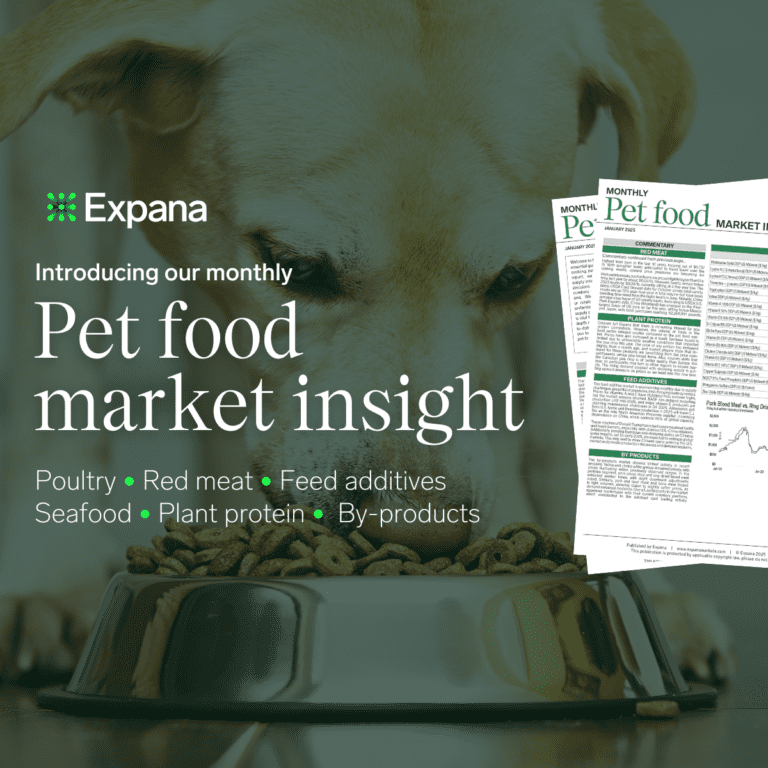EU is facing milling wheat quality challenges
Industry reports are increasingly focused on a significantly reduced wheat crop in France, where adverse weather conditions have taken a toll on production. Strategy Grains by Expana projects French wheat production for the 2024/25 season at 25.6 million mt, a sharp decline of 30% y-o-y and the lowest level since 1986. France’s agriculture ministry offers a slightly higher estimate of 29.7 million mt. At the overall EU level, Strategie Grains by Expana expects that the harvest will be the smallest since 2018. In addition, many EU countries are reporting issues around grain quality, notably specific weights and protein levels. Market players have told Expana that the impact is on the quality with many lots below 76kg/hl test weight, which is a minimum Euronext milling wheat requirement. In Ukraine, market players report that 30% of wheat makes the milling grade. In addition, wheat harvested in north Russia is also of poor quality with a significant portion of it potentially not meeting milling wheat standards. Although more of the crop needs to be harvested before any concrete conclusions can be drawn industry insiders commented that a significant amount of volatility could arise in the wheat market if Russian production and quality decline further. While much of the EU is facing quality challenges, Romania and Bulgaria stand out as the exceptions, producing ‘good quality’ grains this year.
According to the weather reports, the Black Sea region is expected to remain unchanged through mid-August, with heavy rainfall continuing almost daily in Russia’s western spring wheat region. In contrast, Eastern Europe, Ukraine and southern Russia are expected to see little-to-no rain.
Insights and observations post MPOB release
The latest Malaysian Palm Oil Board (MPOB) update was viewed as ‘mildly bullish’ by most market participants, with the report revealing a 5.35% month-on-month (m-o-m) decrease in Malaysian palm stocks to 1.73 million mt in July, the lowest level in three months. This decrease was in line with estimates submitted to Expana before the report signaling a decrease of 3% m-o-m in July’s end stocks. Turning to production estimates, before the report’s release market players told Expana that they expected an increase of 13-14% m-o-m in Malaysian palm production for July. Official estimates pegged production having increased 13.97% m-o-m in July, which is well within market expectations. The most significant aspect of the report was the significant rise in exports, having increased by 39.92% m-o-m in July, according to the MPOB. These exports were far above the market players’ estimations given to Expana before the release, where an increase of 20-22% in the month was estimated.
Market players commented to Expana that the stock decrease owing to significant exports could temper some of the concerns over demand as we progress in August. However, other industry insiders commented that pipelines for China were now ‘well-stocked’. Considering this, market players submitted Chinese palm stock estimates at 510,000 mt in July, a monthly increase of nearly 18%. Moreover, stocks for other key oils within the nation also appear to be heavy with total main vegetable oil stocks currently sitting at over 2 million mt, a two-year high according to industry insiders.
It should be noted that production is likely to be a key watch-out factor in August with early estimates from The Southern Peninsular Palm Oil Millers Association (SPPOMA) placing production at 5.56% lower than in July. However, mid-month production estimates are likely to give a clearer understanding of the August production outlook, as early production in July was unusually large.
Railcar accident sparks explosion at Evonik’s mobile plant
A railcar containing hydrogen peroxide was involved in an accident which led to an explosion at Evonik’s Mobile facility in Alabama on 10 August, according to a statement Evonik provided to the Mobile Fire-Rescue Department and shared with Expana.
The railcar is understood to have experienced overpressure. No serious injuries were reported. Evonik did not immediately respond to request for comment as to whether DL-methionine production or supply was affected.
An Evonik customer said it did not look like the incident was going to result in any supply issues. According to Expana’s Feed Additives Supply & Demand Pro service, the Mobile plant has a capacity of approximately 105,000 tonnes of DL-methionine per year.
In February 2022, Evonik unveiled plans to invest €150 million to add methyl mercaptan production to its Mobile site. The new plant is expected to come onstream in the second half of 2024, and to reach full operational capacity in early 2025.
Media outlets reported that an Evonik spokesperson confirmed that the new construction was not damaged during the explosion.
Insight: vitamin markets in Turmoil after explosion sparks price surge and supply uncertainty
Vitamin markets are experiencing significant fluctuations as stakeholders await BASF’s allocation update following the recent explosion at its Ludwigshafen plant in Germany.
BASF declared force majeure on selected vitamin A, vitamin E, carotenoid products, and aroma ingredients on 7 August following the 29 July explosion at Ludwigshafen. They will reportedly inform customers of allocations on 16 August.
According to Expana’s Feed Additives Supply & Demand Pro service, BASF’s production capacity for vitamin A 1000 in Ludwigshafen is approximately 5,600 tonnes/year. The site also has a nameplate capacity of 15,000 tonnes/year of vitamin E oil.
Many manufacturers and distributors have halted all vitamin offers until they can determine the severity of the damage to BASF’s vitamin production pathways and the expected impact on global vitamin E and A markets for the Q4 2024-Q1 2025 peak winter demand season in the Northern Hemisphere.
Vitamin A spot market reacts
On 13 August, the North American vitamin A 1000 spot price midpoint was assessed at $54.00/kg, up 125% from the midpoint one week earlier. FOB China prices were assessed at $50.00-55.00/kg, up from $25.00-30.00/kg on 6 August, while Europe vitamin A was assessed at €25.00-32.00/kg, up from €23.00-24.00/kg. South American spot price indications firmed to $23.50-25.00/kg, up slightly from $23.50-24.50/kg the week prior.
A Chinese manufacturer reportedly closed vitamin A transactions with North American buyers for $52.00/kg, though exact details and delivery terms were pending.
A North American distributor noted that vitamin A was quoted at $60.00/kg delivered in the US, adding that it believed some larger premixes do not have coverage for Q4 and are waiting for the BASF allocation news later this week.
Another North American distributor mentioned that producers were still not quoting and do not expect any new information before early next week. Indications from the trade side in North America range from $54.00-60.00/kg.
“Crazy days – whenever one price gets confirmed, the next quote moves considerably up from the same source,” the distributor said.
A third North American distributor highlighted that US spot offers last week moved rapidly from the $30.00-40.00/kg range to the $50.00/kg range.
“I do not know if [anyone] is actually buying at these price points, but the markets are trending sharply upward as they try to digest the impact of BASF’s force majeure event,” the distributor added.
A buyer commented that there is no benchmark in the domestic US market, and Europe and Asia manufacturers remain quiet for now. The buyer expected vitamin A prices to be above $56.00/kg in the US prompt spot market.
“As of this morning, some integrators are asking for an extension on bids that end in September or October on concern for vitamin availability,” the buyer said. “For some premixes, it is minor, but for other premixes, there is a higher inclusion.”
“We are all waiting for the ‘BASF Friday’ news update they say we are to get,” the buyer said.
Another US buyer noted, “A, D, and E are all up with some brokers trying to get prices to move higher and some distributors not offering any price until after the BASF announcement on the 16th.”
The market remains highly volatile across all regions, with major producers holding back on Q4 offers until more information is available.
In Europe, vitamin A spot price indications ranged from €25.00-60.00/kg on 13 August due to limited availability and seller caution. Some producers offered limited volumes at higher prices, while others did not offer them at all. Trader price indications were wide, but few actual transactions were confirmed in the European market.
The China vitamin A market saw a significant surge in export price indications on 13 August, with deals concluded at $50.00-60.00/kg FOB. Following BASF’s force majeure declaration, market activity increased sharply, but several sellers are now holding back on offers due to low stock levels and tight downstream supply, according to market sources. Many overseas buyers are concerned about potential price hikes in 2025, leading to a cautious market atmosphere.
Some North American buyers have learned to formulate with less vitamin A 1000 after previous incidents. In addition, some market sources have mentioned that their concern is more for the feedstocks and precursors for vitamin production at the German plant.
Vitamin A historic high in 2017
Vitamin A prices surged to more than €400/tonne delivered in Europe in 2017 due to a feedstock disruption.
On 1 November 2017, a fire occurred at BASF’s citral production plant. On 2 November, force majeure for citral and certain vitamin A precursors was declared. At that time, spot prices rose from €67.00-80.00/tonne to €90.00/tonne. Days later, force majeure on vitamin A was declared, and the European market became highly nervous with isolated cases of broker quotations for strictly limited volumes exceeding €120/kg, according to Expana price history and historical reports. Spot prices moved to €180/tonne just two weeks after the incident.
Some other vitamin A producers depended on the citral facility to supply key intermediates. Q1 producer quotations ceased as suppliers accessed the market where the supply of critical intermediates for vitamin A production remained uncertain for certain producers. In addition, some sellers had difficulty executing Q4 contracts. Some larger strategic end-users used airfreight to shorten delivery times for products they managed to secure from other geographic regions.
Resellers were asking around €200/kg for 500-1,000 kg lots via airfreight at the beginning of November 2017. That number jumped nearly daily to reach €400/kg by the end of the month. At that time, all end-users confirmed delays in receiving contracted materials. By December, prices had exceeded €400/tonne, to reach €460/tonne by the end of the year.
Vitamin E spot market reacts
Meanwhile, the North American vitamin E spot price range also firmed on 13 August, with indications ranging from $20.00-27.00/kg. A North American distributor reported seeing numbers “all over the place,” with a full truckload volume trading for $25.00/kg and offers potentially moving up to $27.00/kg later this week. Another distributor mentioned hearing indications of $20.00-23.00/kg for vitamin E trade in the US from the trade/resell side.
“For E, any local material offered in the low [$20s/kg] is gone,” a US buyer said.
One manufacturer reportedly had a limited supply of vitamin E for $25.00/kg for prompt August delivery.
In Europe, traders have reported selling vitamin E at around €16.00/kg and hearing offers for Q4 at €18.00/kg. Limited volumes are available, and while some producers have stopped offering, others report normal availability but are not quoting prices. Despite the disruptions, Q4 requirements are expected to be covered by existing stocks, according to market sources.
China vitamin E 50% export prices also rose, with transactions ranging from $19.00-25.00/kg FOB.
For further insights, please watch our most recent oilseeds webinar.



